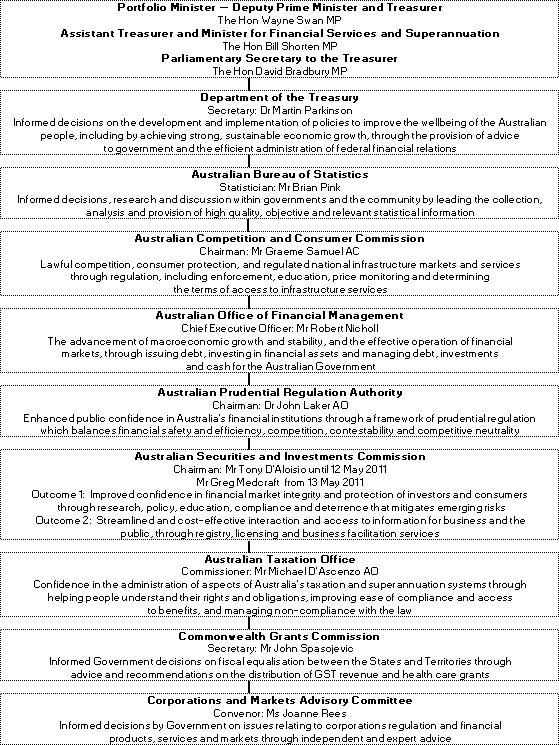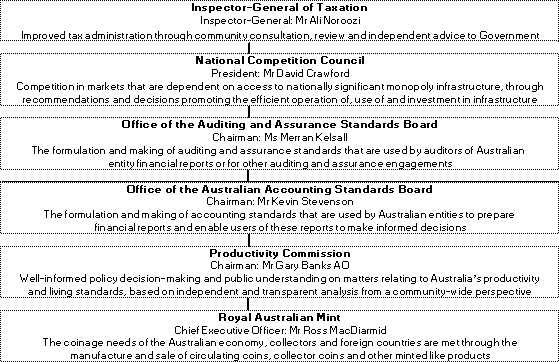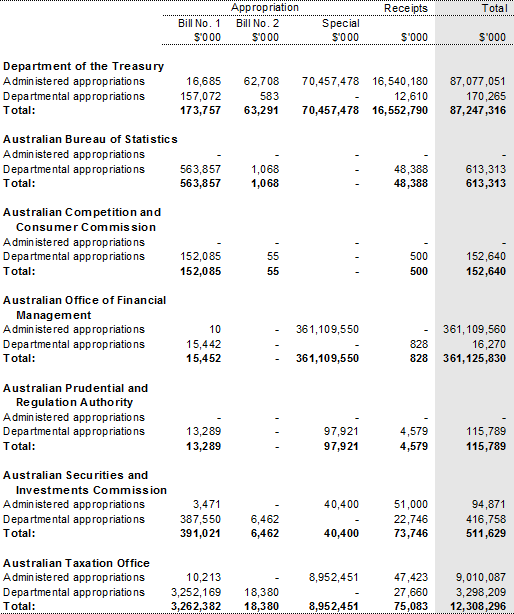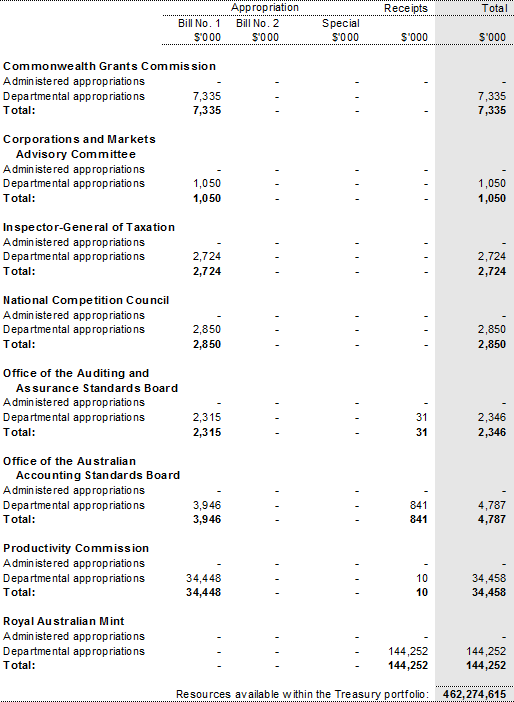Ministers and portfolio responsibilities
The Treasury portfolio undertakes a range of activities aimed at achieving strong sustainable economic growth and the improved wellbeing of Australians. This entails the provision of policy advice to portfolio Ministers and the effective implementation and administration of policies that fall within the portfolio Ministers' responsibilities.
The Treasury portfolio comprises 15 agencies.
The Department of the Treasury's mission is to improve the wellbeing of the Australian people by providing sound and timely advice to the Government, based on objective and thorough analysis of options, and by assisting Treasury ministers in the administration of their responsibilities and the implementation of government decisions. Its outcome is: informed decisions on the development and implementation of policies to improve the wellbeing of the Australian people, including by achieving strong, sustainable economic growth, through the provision of advice to government and the efficient administration of federal financial relations.
The Australian Bureau of Statistics is Australia's official statistical agency. It provides statistics on a wide range of economic, environmental and social matters, covering government, business and the community in general. Its outcome is: informed decisions, research and discussion within governments and the community by leading the collection, analysis and provision of high quality, objective and relevant statistical information.
The Australian Competition and Consumer Commission is an independent statutory authority which administers the Competition and Consumer Act 2010 and performs functions under other Commonwealth legislation and State and Territory Competition Policy Reform Acts. Its outcome is: lawful competition, consumer protection, and regulated national infrastructure markets and services through regulation, including enforcement, education, price monitoring and determining the terms of access to infrastructure services.
The Australian Office of Financial Management is responsible for the management of Australian Government debt and financial assets. Its outcome is: the advancement of macroeconomic growth and stability, and the effective operation of financial markets, through issuing debt, investing in financial assets and managing debt, investments and cash for the Australian Government.
The Australian Prudential Regulation Authority is the financial supervisor responsible for the prudential regulation of the banking, other deposit taking, insurance and superannuation industries. Its outcome is: enhanced public confidence in Australia's financial institutions through a framework of prudential regulation which balances financial safety and efficiency, competition, contestability and competitive neutrality.
The Australian Securities and Investments Commission is the independent government body that administers and enforces corporate and financial services law. Its areas of regulatory responsibility include market integrity and consumer protection in the financial services sector, investment management (including superannuation), capital markets (including market supervision), consumer credit, corporations and auditors and liquidators. It has two outcomes: improved confidence in financial market integrity and protection of investors and consumers through research, policy, education, compliance and deterrence that mitigates emerging risks; and streamlined and cost-effective interaction and access to information for business and the public, through registry, licensing and business facilitation services.
The Australian Taxation Office is the Australian Government's principal revenue collection agency and administers Australia's taxation system and significant aspects of Australia's superannuation system. It administers legislation governing taxation, superannuation and the Australian Business Register and supports the delivery of government benefits to the community. Its outcome is: confidence in the administration of aspects of Australia's taxation and superannuation systems through helping people understand their rights and obligations, improving ease of compliance and access to benefits, and managing non-compliance with the law.
The Commonwealth Grants Commission provides advice to government on the equitable distribution of GST revenue and health care grants to state and territory governments. Its outcome is: informed Government decisions on fiscal equalisation between the States and Territories through advice and recommendations on the distribution of GST revenue and health care grants.
The Corporations and Markets Advisory Committee is the independent government body that provides informed and expert advice to the government about corporate, financial product and financial market matters. Its outcome is: informed decisions by Government on issues relating to corporations regulation and financial products, services and markets through independent and expert advice.
The Inspector-General of Taxation seeks to improve the administration of the tax laws for the benefit of all taxpayers. Its outcome is: improved tax administration through community consultation, review and independent advice to Government.
The National Competition Council is an independent advisory body for all Australian governments that advises and makes recommendations under the National Access Regime and recommendations and decisions in relation to natural gas pipelines. Its outcome is: competition in markets that are dependent on access to nationally significant monopoly infrastructure, through recommendations and decisions promoting the efficient operation of, use of and investment in infrastructure.
The Office of the Auditing and Assurance Standards Board's mission is to develop, in the public interest, high quality auditing and assurance standards and related guidance as a means to enhance the relevance, reliability and timeliness of information provided to users of audit and assurance services. Its outcome is: the formulation and making of auditing and assurance standards that are used by auditors of Australian entity financial reports or for other auditing and assurance engagements.
The Office of the Australian Accounting Standards Board's mission is to develop and maintain high quality financial reporting standards for all sectors of the Australian economy and contribute, through leadership and talent, to the development of global financial reporting standards and be recognised as facilitating the inclusion of the Australian community in the activity of global standard setting. Its outcome is: the formulation and making of accounting standards that are used by Australian entities to prepare financial reports and enable users of these reports to make informed decisions.
The Productivity Commission is the Government's independent research and advisory body on a range of economic, social and environmental issues affecting the welfare of Australians. Its outcome is: well-informed policy decision-making and public understanding on matters relating to Australia's productivity and living standards, based on independent and transparent analysis from a community-wide perspective.
The Royal Australian Mint manufactures and sells circulating coins to meet the coinage needs of the Australian economy, and collector coins and other minted products for Australia and foreign countries. Its outcome is: the coinage needs of the Australian economy, collectors and foreign countries are met through the manufacture and sale of circulating coins, collector coins and other minted like products.
Figure 1: Treasury portfolio structure and outcomes

Figure 1: Treasury portfolio structure and outcomes (continued)

Portfolio resources
Table 1 shows the total resources provided to the portfolio in the 2011-12 budget year, by agency.
Table 1: Portfolio resources 2011-12

Table 1: Portfolio resources 2011-12 (continued)
